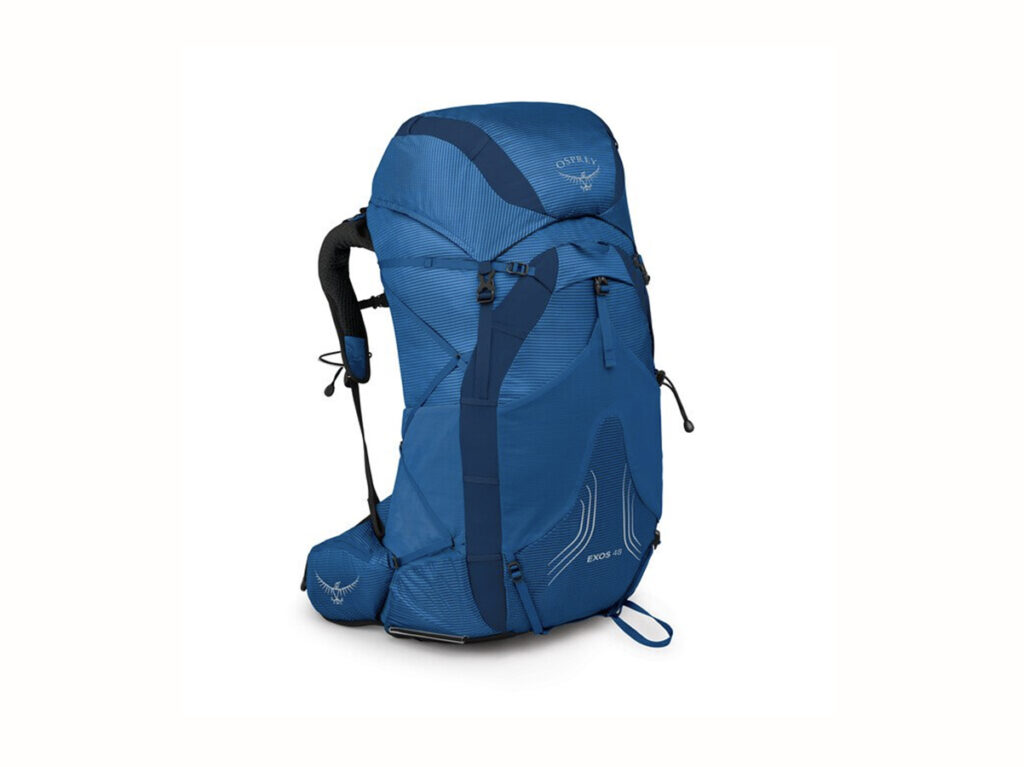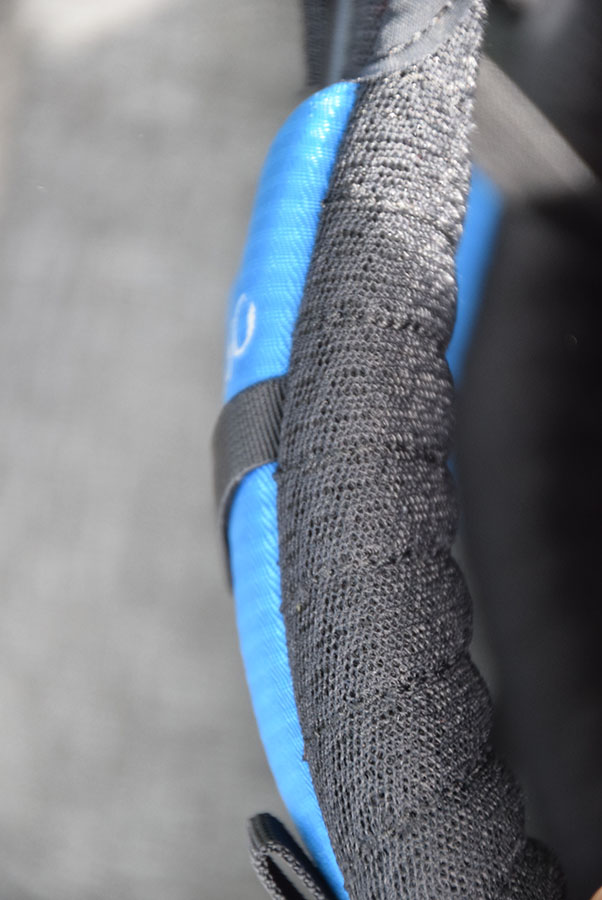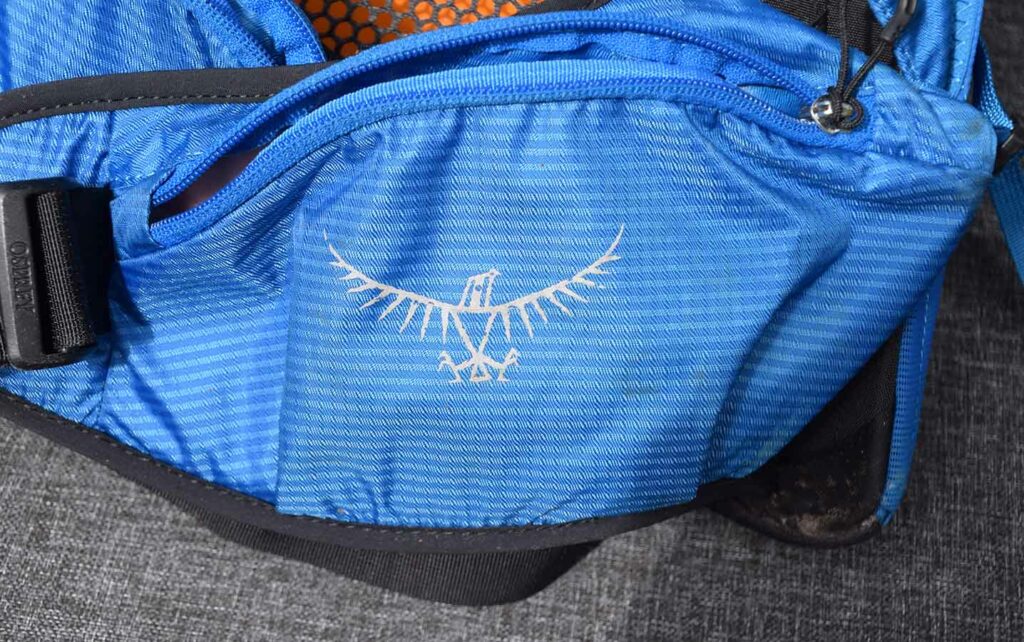Osprey Exos 48 Pack
Backpack
Rating
| Rating: | 8.7 / 10 |
| Value for Money | 1.8 / 2 |
| Comfort | 1.7 / 2 |
| Weight | 1.7 / 2 |
| Durability | 1.7 / 2 |
| Versatility | 1.8 / 2 |
Osprey Exos 48 Pack Review
This is the third Osprey Exos pack I have owned. While I preferred the Osprey Atmos 50 pack for the past few years, Osprey has done a really good job in redesigning this pack. So much so, this the best of the three versions I have used. This latest version can best be described as an evolution in design rather than a revolution. Upfront I’ll state that this has now become my go-to pack for hikes longer than 4-5 days in duration where I need a bit more pack space.
So what’s so special about this new version of the Osprey Exos 48? By far the feature that draws me back to this pack is the suspension system (Osprey call this their Airspeed Suspension™) that connects the pack to the wearer. In plain English this is a ‘trampoline’ style system that apart from the hips and the shoulders, provides an air gap along the length of the back. In summertime even on very hot days (30+° Celsius) I find that the improved airflow keeps me more ventilated compared to packs that have full contact along the entire back. This system has been retained with the new model. There is one slight downside that I’ll talk about but it isn’t a deal breaker.
Now there are some negatives to this style of pack suspension. When the pack is loaded with less than around 7kg it feels like its ‘floating’ which can be annoying. As such, I tend not to wear this pack as a day pack but instead opt for models specifically designed for day use. The lower half of the suspension on this pack is joined to the pack which actually gets in the way if you are using a pack cover. In earlier models the strap that keeps the cover in place fed under the suspension. However, that’s not an option with this newer model so you have to leave the cover unclipped or opt for a larger cover with a longer strap.
This pack comes in two torso lengths so the starting point is working out what size you are by measuring your torso. One new addition is the ability to fine tune the adjustment of the suspension length. Once you have set this pack up, its something you don’t need to consider again but its a nice feature to have. One thing to be aware of is that I, like many other hikers, swing this pack off my left shoulder when I take it off. When you do this, there tends to be a bit of a ‘popping sound’ when you put it back on as the adjustment clip clicks back into place. Not a negative but it took me a day or two to work out what was going on.
The heaviest I ever load Exos packs is around 21kg. This is only when hiking in desert environments when I have to carry big water loads and typically only for a short period. I personally find that the Exos is comfortable up to around 18kg. If a really heavy load was the norm I would probably opt for a pack that has more heavy duty padding such as the Atmos or Aether. I am currently using my older Exos for pack training.
Size wise this pack remains unchanged. For my L-XL size the capacity is 51 litres which suits me well up to trips of 10-12 days in duration. The pack brain is removable which also remains unchanged from previous versions but this is something I have never done preferring to have the additional space to store all the little bits and pieces I carry. This pack also comes in a 58 litres size and rather than lengthening the pack it is wider which make this a great option for shorter hikers. The dimensions of the 58 litre pack are ideal for use in the USA where carrying bear cans is required.
The large stretchy pocket at the rear of the pack is usually where I store my tent. The lightweight two person tents comfortably fit into this stretch pocket even though they make the pack bulge. The closure clip on this pocket now has a protective covering which while not necessary means you won’t confuse this with other straps. If I’m bush bashing through rough bush I’ll put the tent inside the main pack.
When Osprey released the last version of this pack in Australia in 2018 many hikers were disappointed. To my dismay, and many others, the previous version didn’t have hip belt pockets; not happy Jan! (For those outside Australia this is a pop culture reference.) I was thrilled when I caught up with the Australian distributor of Osprey packs to find not only had the pockets been reinstated, the size had been increased. Yaayyy!! While these pockets aren’t as big as those on the larger heavier packs, I find that if I use one for hand sanitiser and the other for the daily snacks, I still have space left over. These pockets are even large enough for a compact camera.
The internal water bladder pocket still remains in this pack with the feeder hole for the drinking tube centred which means it doesn’t matter which side you prefer the tube to come down. Given that the female end of the sternum strap is on the left hand side, you would need to remove the drinking tube before taking the pack off if you do run it down the left so the right side is a better option.
This pack has also increased in weight ensuring a more robust material. It has 400D High Tenacity Nylon in some areas on the bottom of the pack to provide additional robustness but wear and tear on these packs has never been an issue for me. Given the addition of some heavier materials as well as the hip belt pockets, the increase in weight is only round 120 grams bringing the L-Xl pack weight to 1.294kg. The durability of this pack isn’t an issue and even my 6 year old version of this pack, which now permanently lives with 18kg of weight, is still in very good condition.
One other consideration is that the waist belt has limited adjustment. If your waist is anything over 106cm (42 inches) and you are likely to be wearing bulky clothing, then you’re definitely best trying before you buy. If purchasing online, seeking out a supplier that has a good return policy will be important to ensure you get the right fit.
This pack comes with a great range of other features including numerous equipment loops and the well known Stow on the Go™ hiking pole system. If you are using poles that compress rather than fold down this is a great systems. After a little bit of practice its very easy to put them away while you walk. Unfortunately I’ve changed to a lightweight pair of poles that no longer suit this system.
There is also a new female version of this pack called the Eja which is worth considering but don’t rule out the Exos just because its not a ‘female’ pack. While I still think there can be minor tweaks, this is the best version of the Exos pack produced by Osprey and it’s just about perfect for loads up to the 16-18kg range.
We Like
- Pack weight of 1.294 kg means less stress on the body and with it an easier hike
- The Airspeed Suspension™ means you are much less likely to get a sweaty back
- Removable six litre ‘pack brain’ that allows versatility in the pack configuration and the potential to strip the pack weight down if not needed. With the brain removed a simple ‘Flap Jacket’ is integrated into the pack
- Deep mesh water bottle pockets that stretch to comfortably fit Nalgene style bottles and other accessories such as tent poles and integrated stoves. This again allows for packing versatility
- Large stretchy mesh rear pocket ideal for storage your shelter plus other flexible equipment. This greatly increases the size of pack carrying capacity
- This pack allows a great deal of freedom and very clean across at the front
- Increased durability across the bottom of the pack in this model provides a longer lifespan for those rough on their gear
We Don't Like
- The internal water bladder pocket means you need to pretty much unpack all equipment to remove and fill up the water bladder if you have a full pack
- The pack is extremely popular for hikers doing the American long trails including the Pacific Crest Trail, Appalachian Trail and Continental Divide Trail as well as the El Camino in Spain. If you want to get hold of one for a hike, particularly at the start of the calendar year, then buy it well in advance
Best Uses
- Lightweight hikers and those heading towards ultralight.
- This pack handles loads up 18kg with comfort and for short periods loads of 21kg is bearable
Buy One
You can purchase the Osprey Exos 48 pack online from Wild Earth or from Wildfire Sports
Disclosure: We may earn a small commission, at no additional expense to you, if you click through and make a purchase. Please note that our affiliations do not influence, in any way, the independence of our reviews. If we don’t like a product, you’ll hear about it from us!
Investment
AUD $379.90 RRP
Other Versions
- Osprey Exos 58
- Eja 48 Female pack
- Eja 58 Female pack

Osprey Exos 48 – Blue Ribbon colour

Osprey Exos 48 – Tungsten Grey colour

Image showing internal water bladder pocket on my Osprey Exos 48 pack

Shoulder strap padding. The straps aren’t overly thick compared to packs designed for heavy loads but they have been beefed up since the previous model and will cope well with loads of around 18kg

Pack Brain with zip open. The opening is not excessively wide but you can still fit quite a lot into this compartment. I try to put what I need fo the day in the brain to limit opening up the main pack

Inside pocket pack brain with key holder

Carry handle and hydration bladder port. Even though the hydration tube can go either way it still works best on the right

Exos 48 waist belt has good sized pockets in this new version

Large stretch pocket on the back of the pack. This is where my tent lives

Bottom of the pack with tie down strap for either a tent or foam sleeping mat. This section has been beefed up to prevent abrasion but I have never found this to be an issue

Osprey Exos 48 – back suspension fine tuning

Airspeed Suspension™. This is the main reason I use this pack. Even in summer I don’t sweat that much with this suspension system

Tim with Exos 48 rear view

Tim with Exos 48 in rain cover
Disclaimer
This review was done with product provided by the Australian supplier of Osprey Packs
Last updated
1 February 2024